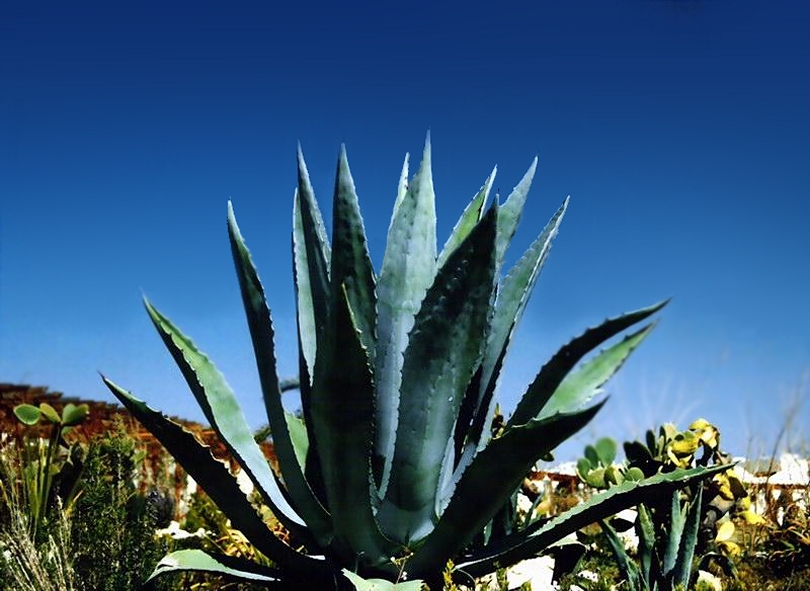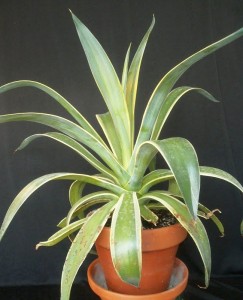Want to learn to grow Agave??
Overview and Description:
At first glance, you probably wouldn’t be called agave plants rosettes. So many of the common ones are spiny succulents, with leaves that jut out in often dangerous looking spikes. There is actually a lot of variety in the agave genus. There are the large, stiff specimens that can grow to 20 feet in diameter. There are also small dish-sized agaves and agave plants with soft leaves and no spines. Most have leaves that do end in a sharp point.
 Leaves: Agaves are all stemless, or nearly so, with strappy, succulent leaves that end in sharp points. Foliage tends toward a blue-green in hardier varieties and a gray-green in warm climate varieties. There are also some that are variegated varieties with gold or white markings.
Leaves: Agaves are all stemless, or nearly so, with strappy, succulent leaves that end in sharp points. Foliage tends toward a blue-green in hardier varieties and a gray-green in warm climate varieties. There are also some that are variegated varieties with gold or white markings.Flowers: When the plant matures, a tall, flower-stalk grows out of the plant’s center. The flowers are bell-shaped and long-lasting, in shades of white, yellow and green. For most agave species, once the flowers produce the berry seed pods, the plant dies. But this can take years.
Botanical Name:
Agave
Common Name(s):
Sometimes referred to as the Century Plant, although that name is specific to Agave americana
Hardiness:
Most are not very frost hardy, but there are agaves, like Agave parryi, that are hardy to USDA Zone 5, but most are only hardy in Zones 8 or 9 and up.
Light Exposure:
Full sun to partial shade
Mature Size:
Varies from a few inches to 20+ feet in diameter.
Bloom Period:
Agaves bloom once, at maturity. That can be anywhere from 5 to 40 years. They tend to bloom earlier in cultivation than they would in the wild. Most plants die after flowering.
Design Tips:
One large agave is all that is needed to make a sculptural focal point. Just make sure there is plenty of room to walk around it, so no one gets stabbed. They can also make a great border grouping, either by planting several of the same species or a tapestry of different varieties. They are textural and sculptural and make a vivid contrast with other plants. Pairing them with ornamental grasses softens their hard edges. In really warm climates, agave is popular around pools and patios. Their leaves don’t brown and drop frequently and they stay attractive all year. I’d suggest using a spineless variety, like the Foxtail Agave (Agave attenuata). Smaller agave plants are excellent for containers, indoor or outside.
Suggested Varieties:
Agave attenuata– A popular spineless variety also known as the Foxtail or Dragon-Tree Agave. Grows about 4 – 5 feet tall and a bit wider.
Agave parviflora– Leaves have white, graphic markings and curling filaments that give it a hairy look. It only gets about 6 in. Tall and blooms in 6 – 8 years with green flowers on a 4 – 6 ft. spike.
Agave tequilana azul– Weber’s Blue Agave is used to make tequila, in Jalisco, Mexico, but it is also a very attractive garden plant, reaching upwards of 6 ft. tall and flowering in 6 – 8 years with a 15 ft. spike of yellow blooms.
Agave victoria-reginae– As the plant matures, the broad leaves cup inward, forming a dome. Reaches a height of about 12 in.. Cream flowers appear in 20 – 30 years
Growing Tips:
Agaves thrive on neglect. They grow quickly and remain attractive all year.
Propagation: Since it can take years for agaves to produce seed, most are propagated by offsets or tissue culture.
Soil: Agave will tolerate any well-draining soil, but their preference is rocky or sandy soil. They are not particular about soil pH.
Water: When you are first establishing a plant outdoors, water it every 4 – 5 days for the first month. Then once a week, gradually spacing watering to every other week, depending on the weather.
Feeding: Don’t. Agaves seem to take care of themselves. Feeding encourages flowering, which you don’t want to happen too soon.
Growing in Containers: Container Grown Agaves: As with many succulent plants, agaves are shallow rooted. You can grow them in any size container because they don’t need to allot of soil. Use a well-draining soil. You can mix your own with something like 2 – 3 parts potting mix and 1 part gravel.
Report container grew plants every couple of years, with new soil. Agaves can produce sucker roots. If the pot overly crows with roots, go ahead and cut it back to size. Give the plant a week or so to readjust, before you water it again.
Water about once a week in the summer and monthly in the winter, when the surface of the soil is dry. Plants in containers or in dry conditions may need more frequent water, but agaves are very forgiving.
Want to grow Agave indoors?

Agave can be exceptional houseplants, depending on which one you buy. There are about 450 species of agave, including the famous century plant (which, for the record, does flower more often than once a century). As desert plants, agave appreciates direct, abundant sunlight and very light water. They are slow-growing, so even specimens that grow into large plants can be kept inside for a period of time before they outgrow the room. Agave is not very “people friendly;” their sap tends to be irritating and most of them feature truly intimidating spines on their leaves that make brushing against them a painful adventure.
Light: Bright sunlight year-round. Consider moving your plants outside during the summer, where they can enjoy full sunlight, and make sure they get plenty of winter light.
Water: In spring, water with warm water just as the soil begins to dry out. Don’t let the soil become completely dry. In the winter and fall, when growth is suspended, water very lightly.
Temperature: They prefer warm spring and summer temperatures (70-90ºF) and cooler fall and winter temps (50-60ºF).
Soil: Use standard succulent or cacti potting mix.
Fertilizer: Feed in spring and summer; do not feed during fall and winter.
Water: In spring, water with warm water just as the soil begins to dry out. Don’t let the soil become completely dry. In the winter and fall, when growth is suspended, water very lightly.
Temperature: They prefer warm spring and summer temperatures (70-90ºF) and cooler fall and winter temps (50-60ºF).
Soil: Use standard succulent or cacti potting mix.
Fertilizer: Feed in spring and summer; do not feed during fall and winter.
Grower’s Tips:
Agave is not a difficult plant to grow. They’re slow-growing and dramatic and will even thrive on some neglect. If you’re the type of person who likes to fuss with houseplants and water a lot, agave might not be the plant for you. If, however, you’re the type of person who likes to set it and forget it, and you have a sunny window, agave might the way to go. Be aware that some of the large varieties will eventually outgrow your room (unless you have a large greenhouse), and agave can be aggressive. They have irritating sap and sometimes very sharp thorns that can cause injuries to small children and even pets. Until next time…Happy Gardening!!